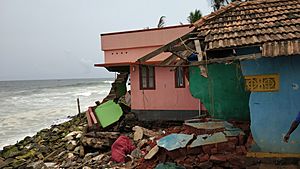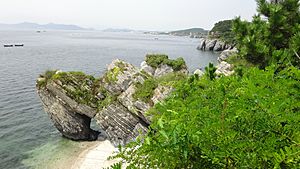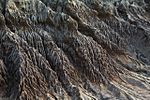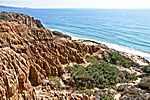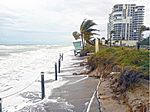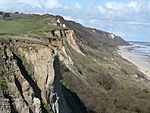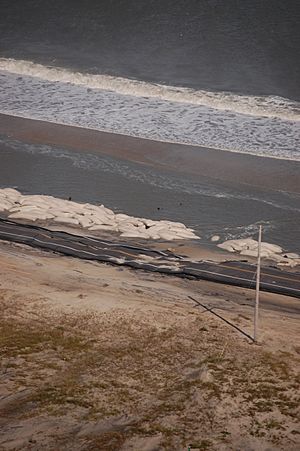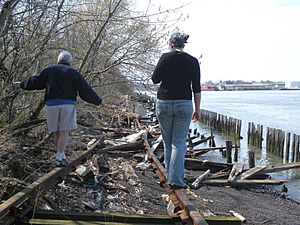Coastal erosion facts for kids
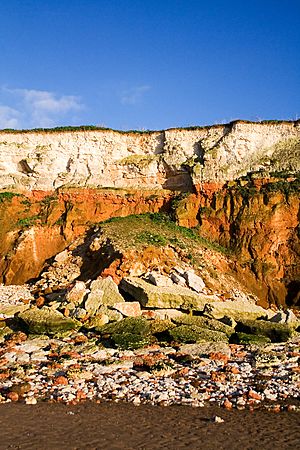
Coastal erosion is when land, sand, or rocks along the coastline are worn away or moved. This happens because of strong forces like waves, currents, tides, wind, and even ice. It's like the ocean is slowly "eating away" at the land.
This process can be seen over short times, like with tides, or over many years. Coastal erosion can be caused by the sheer force of water (hydraulic action), rocks grinding against each other (abrasion), or even chemicals in the water (corrosion).
On coasts that aren't made of hard rock, erosion can create cool rock shapes. Softer parts of the land wear away faster than harder parts. This can lead to natural tunnels, bridges, and tall pillars. Over time, the coast often becomes smoother as the softer areas fill with sand from the harder parts. Erosion also happens a lot where there are strong winds, loose sand, and soft rocks. The wind blows millions of tiny sand grains, which act like a sandblasting machine, smoothing and polishing rocks.
Experts say that sea level rise, which is linked to climate change, will make coastal erosion worse around the world. This will greatly change our coasts and low-lying areas.
Contents
How Coasts Erode
Hydraulic Action
Hydraulic action happens when waves crash against a cliff. The waves push air into cracks in the cliff face. This trapped air puts a lot of pressure on the rock, which can make pieces break off. Over time, these cracks can grow and even form a cave. The broken pieces then fall into the sea.
Attrition
Attrition is like rocks bumping into each other. When waves move loose rock pieces (called scree), these pieces crash together. They grind and chip each other, becoming smaller, smoother, and rounder. These rock pieces also hit the bottom of the cliff, chipping off more small bits of rock. This is similar to how sandpaper works.
Solution
Solution is a chemical process. Acids found in seawater can dissolve certain types of rock, like chalk or limestone. It's like the water is slowly melting the rock away.
Abrasion
Abrasion, also known as corrasion, happens when waves break on cliff faces. The waves use the loose rock pieces (scree) that are already in the water to batter and break off more rock from the cliff. This process slowly wears down the cliff.
Corrosion
Corrosion is another chemical process. It occurs when the seawater's acidity (its pH level) reacts with and breaks down rocks on a cliff face. Limestone cliffs are especially affected by this. The constant movement of waves helps speed up this reaction by washing away the dissolved material.
What Makes Erosion Faster?
Many things affect how quickly a cliff or coastline erodes.
Main Factors
- Rock Strength: How hard or soft the rocks are makes a big difference. Rocks with lots of cracks or soft layers like silt and fine sand erode faster.
- Wave Power: Stronger waves can remove broken rock pieces from the shore more easily. Sometimes, piles of broken rock can stay for many years before they are completely washed away.
- Beaches: Beaches are changed in shape chiefly by the movement of water and wind. Any weather event that is associated with turbid or fast flowing water, or high winds will erode exposed beaches. Tidal waterways generally change the shape of their adjacent beaches by small degrees with every tidal cycle. Over time these changes can become substantial.
- Foreshore Stability: A stable foreshore (the area between the low and high tide marks) can spread out wave energy. If sand and other materials keep arriving at the foreshore, it helps keep the beach stable.
- Seafloor Shape: The shape of the seafloor (called bathymetry) near the coast affects how much wave energy reaches the shore. Underwater sandbars can make waves break and lose their energy before they hit the coast.
- Rising Sea Levels: Globally, rising sea levels have greatly increased coastal erosion. For example, places like Florida in the United States have seen much more erosion. This has led to bigger budgets to replace lost sand, which helps their tourism industry.
- Coastal erosion
-
Pacifica, California coast after major storms in 1997.
-
Beach erosion at Cabrillo National Monument, California.
-
Large-scale coastal erosion at Torrey Pines State Reserve, California.
-
Coastal erosion at Torrey Pines State Reserve, California, led to moving a scenic overlook.
Other Factors
- Weathering and how slopes move material.
- Water flow on slopes.
- Plants and trees (vegetation).
- Erosion at the bottom of cliffs.
- How much sediment builds up at the bottom of cliffs.
- How well cliff-foot sediment resists being worn away and moved.
- Things people do (Human Activities).
Bigger Picture Factors
- Taking resources from the land.
- How we manage our coasts.
How to Control Erosion
There are three main ways to try and control coastal erosion: soft controls, hard controls, and moving things away from the coast.
Hard-Erosion Controls
Hard-erosion controls are more permanent solutions. These include building Seawalls and groynes. Seawalls are strong barriers built along the coast to block waves. Groynes are structures built out into the sea to trap sand and prevent it from being washed away.
These structures can last a long time (50-100 years for seawalls, 30-40 years for groynes). However, they need to be repaired or rebuilt over time. While they seem like a final solution, they can also block public access to beaches and change the natural look of the coast. Some people argue that these structures can actually cause more problems. They can interfere with natural water currents, stop sand from moving along the coast, and are very expensive to build and maintain. They can also cause erosion on nearby beaches.
Natural hard controls include planting or protecting plants like mangrove forests and coral reefs, which act as natural barriers.
Soft-Erosion Controls
Soft erosion controls are temporary ways to slow down erosion. These are not meant to be permanent fixes. Examples include using sandbags or adding new sand to beaches (called beach nourishment).
Another method is "beach scraping" or "beach bulldozing." This involves moving sand to create an artificial sand dune in front of buildings to protect them. However, in the U.S., this is not allowed during turtle nesting season (May 1 to November 15).
Beach nourishment projects are very common. They involve digging up sand from elsewhere and moving it to beaches to replace what has been lost. But this isn't always a good solution, especially in areas with strong storms or where sand quickly disappears.
Beach nourishment can be controversial because it can harm natural environments. These projects also have to follow many complex laws and are very expensive. Sometimes, communities add huge amounts of sand, only for it to be washed away by the next big storm. Despite these issues, beach nourishment is still used often. Recently, experts have started looking for new solutions, like using native plants, protecting wetlands, and even moving buildings away from the coast.
Living Shorelines
Solutions that use plants and other natural elements are called "living shorelines." These are often stronger against storms, improve water quality, increase different types of plants and animals, and create homes for fish. Marshes and oyster reefs are examples of living shorelines. They act like natural walls against waves. Just 15 feet of marsh can absorb half of the energy from incoming waves!
Relocation
Moving buildings and other structures farther away from the coast is another option. This takes into account the natural processes of sea level rise and erosion. Depending on how bad the erosion is and the landscape, relocation might mean moving a short distance inland or completely removing buildings from an area.
While people often don't like the idea of "retreating" from the coast, if a community decides to move its buildings, the land often becomes public open space or is protected. This can save money, protect homes from storm surges, improve air quality, create homes for fish, and restore natural areas.
Tracking Erosion
Storms can cause erosion hundreds of times faster than normal weather. Scientists can track erosion by comparing before-and-after pictures using surveys, lasers, or GPS. Satellite data can also be used to see how coastlines change over many years.
Examples of Coastal Erosion
- At Wamberal in Australia, houses built on cliffs started to fall into the sea. This happened because waves eroded the soft rock the houses were built on.
- Dunwich, an important medieval town in England, disappeared over a few centuries because waves moved all the sand and sediment away.
- Human actions can also make erosion worse. The village of Hallsands in England was washed away in 1917. This was directly caused by earlier dredging (removing) of shingle from the bay in front of it.
- The California coast in the U.S. has soft cliffs and many homes. Areas like Devil's Slide, Santa Barbara, and Malibu often see homes damaged as cliffs erode.
- The Holderness coastline in England is one of the fastest eroding coastlines in Europe. It has soft clay cliffs and strong waves. Man-made structures like groynes have sometimes made the problem worse further down the coast, as they stop sand from reaching those areas. The famous white cliffs of Dover have also been affected.
- North Cove, Washington in the U.S. has been eroding over 100 feet per year, earning it the nickname "Washaway Beach." Much of the original town has fallen into the ocean.
- Fort Ricasoli, a historic 17th-century fortress in Malta, is threatened by erosion. It was built on a weak spot in the land. Part of a wall has already collapsed, and other walls have cracks.
- In El Campello, Spain, a Roman fish farm from the first century B.C. was damaged by erosion. This problem got worse when a nearby sport harbor was built.
- Hampton-On-Sea in Kent, England, was once a popular fishing town. It suffered greatly from coastal erosion, especially with rising sea levels and more intense storms due to global warming. The Hampton Pier, gardens, villas, and roads were destroyed. A seawall was built in 1899, but it didn't help much. Eventually, the town had to be abandoned by 1916. By the 1920s, almost nothing was left. Today, only three landmarks remain: The Hampton Inn (now a pub), The Hampton Pier (smaller but still used for fishing), and a few roads.
See also
 In Spanish: Erosión costera para niños
In Spanish: Erosión costera para niños
- Beach erosion and accretion
- Beach evolution
- Beach morphodynamics
- Beach nourishment
- Raised beach
- Modern recession of beaches
- Paleoshoreline
- Integrated coastal zone management
- Coastal management, to prevent coastal erosion and creation of beach
- Coastal and oceanic landforms
- Coastal development hazards
- Coastal geography
- Coastal engineering
- Coastal and Estuarine Research Federation (CERF)
- Erosion
- Bioerosion
- Blowhole
- Natural arch
- Wave-cut platform
- Longshore drift
- Deposition (sediment)
- Coastal sediment supply
- Sand dune stabilization
- Submersion


